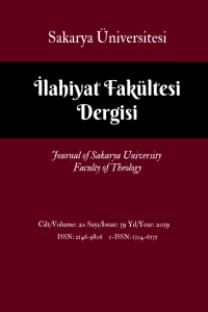KUŞEYRÎ’NİN NAHİV İLMİNE DAİR TASAVVUFÎ YORUMU
Qushayri is one of the important Sufis of 11th century. He wrote a number of books aboutSufism including Risalah and Lataif al-isharat, the last of which has been seen as one of thegreat esoteric commentaries of the Holy Qur'an. There is another treatise of his, called Nahval-Qulûb (or al-Nahv al-muawwal), in which he interprets the rules of Arabic grammar from aSufi perspective. This interesting treatise is like a bridge between Sufism and the Arabicphilology. It is a well-known fact that the basic sciences of Islam ('ulum ash-shar'iyya) includingSufism were closely knit together. However, the relationship of Sufism to Arabic philology isnot very well documented by both classical and contemporary writers. This treatise, whichseems to be early work in this respect, focuses on this particular subject. This paper shallanalyze the content of this treatise and try to explain some of the concepts used in it.
Anahtar Kelimeler:
Tasavvuf, Nahiv, Abdülkerim Kuşeyrî, İşârî Yorum, Sâlik
Qushayri’s Esoteric Commentary about rural of Arabic Grammar
Qushayri is one of the important Sufis of 11th century. He wrote a number of books about Sufism including Risâlah and Latâif al-ishârât, the last of which has been seen as one of the great esoteric commentaries of the Holy Qur’an. There is another treatise of his, called Nahv al-Qulūb (or al-Nahv al-muawwal), in which he interprets the rules of Arabic grammar from a Sufi perspective. This interesting treatise is like a bridge between Sufism and the Arabic philology. It is a well-known fact that the basic sciences of Islam (‘ulum ash-shar‘iyya) including Sufism were closely knit together. However, the relationship of Sufism to Arabic philology is not very well documented by both classical and contemporary writers. This treatise, which seems to be early work in this respect, focuses on this particular subject. This paper shall analyze the content of this treatise and try to explain some of the concepts used in it.
Keywords:
Sufism, Arabic Grammar, ‘Abd al-Karim al-Qushayri, Esoteric Commentary, Darwish,
___
- Akkuş, Süleyman, Kuşeyrî’nin Hayatı, Eserleri ve Kelâmî Görüşleri, (Basılmamış Doktora Tezi), Selçuk Üniversitesi Sosyal Bilimler Enstitüsü, Konya 1997.
- Cebecioğlu, Ethem, Tasavvuf Terimleri ve Deyimleri Sözlüğü, Anka Yayınları, İstanbul 2004.
- Cürcânî, Seyyid Şerif, Kitâbü’t-Ta‘rîfât, Beyrut 1983.
- Durmuş, İsmail, “Nahiv”, DİA, XXXII (İstanbul 2006), s. 300–306.
- Göztepe, Yüksel, Abdulkerim el-Kuşeyrî’de Haller ve Makamlar, (Basılmamış Doktora Tezi), Ankara Üniversitesi Sosyal Bilimler Enstitüsü, Ankara 2006.
- Hekimoğlu, Muhammet, “Dilbilgisi-Tasavvuf Sentezi Bir Risale: Nahvu’l-Kulûb”, Nüsha Şarkiyat Araştırmaları Dergisi, Yıl: VII, Sayı: 25, 2007/II, ss. 21-36.
- İbn Hişâm, Ebû Muhammed Abdullah Cemâlüddin el-Ensârî, Şerhu Katri’n-nedâ ve Belli’s-sadâ, Arslan Yayınları, İstanbul ts.
- Kara, Mustafa, “İbn Acîbe”, DİA, XIX (İstanbul 1999), s. 294-295.
- Kâşânî, Abdürrezzâk, Letâifü’l-a‘lâm fî işârâti ehli’l-ilhâm: Tasavvuf Sözlüğü, (çev. Ekrem Demirli), İz Yayıncılık, İstanbul 2004.
- Kâtip Çelebi, Hacı Halife, Keşfü’z-zünûn, I-II, İstanbul 1943.
- Kılıç, Hulûsî, “İbn Âcurrûm”, DİA, XIX (İstanbul 1999), s. 95–96.
- Kuşeyrî, Abdülkerim b. Hevâzin, en-Nahvu’l-müevvel (Te'vîlü Istılahâti'n-Nahv bi-meâni's-sufiyye), Süleymaniye Ktp. Hacı Mahmud Efendi, nr. 2040.
- er-Risâle: Tasavvuf İlmine Dair Kuşeyrî Risâlesi, (haz. Süleyman Uludağ), İstanbul 1991.
- Nahvu’l-kulûbi’l-kebîr, (tahkik ve şerh: İbrahim Beysûnî - Ahmed Alemü’d-dîn el-Cendî), Kahire 1994.
- Uludağ, Süleyman, “Abdal”, DİA, I (İstanbul 1988), ss. 59–61.
- “Kuşeyrî, Abdülkerim b. Hevâzin”, DİA, XXVI (Ankara 2002), s. 473–475.
- Tasavvuf Terimleri Sözlüğü, İstanbul 1991.
- ISSN: 2146-9806
- Yayın Aralığı: Yılda 2 Sayı
- Başlangıç: 2001
- Yayıncı: Sakarya Üniversitesi
Sayıdaki Diğer Makaleler
KUŞEYRÎ’NİN NAHİV İLMİNE DAİR TASAVVUFÎ YORUMU
'RİVAYET TEFSİRİ' KAVRAMI VE KUR'AN'IN KUR'AN İLE TEFSİRİ: ELEŞTİREL BİR YAKLAŞIM
MİSKEVEYH'İN 'ADALET ÜZERİNE' ADLI YAYINLANMAMIŞ RİSALESİ
DOĞA YASALARININ ZORUNLULUĞU, İLAHİ FİİL VE MUCİZE -TANRI DÜNYADA FİİLDE BULUNABİLİR Mİ?-
İBN ATIYYE’NİN TEFSÎRİNİN ŞİİRLE İSTİŞHAD YÖNTEMİ AÇISINDAN DEĞERİ
İSLÂM’DA ŞÛRÂ VE ENDÜLÜS UYGULAMASI
